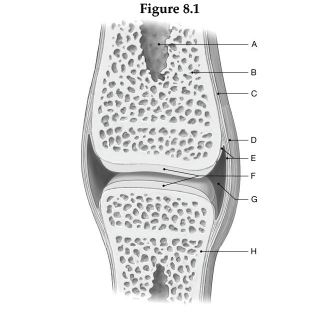Using the figure below, identify the labeled items.

1) Label A: ______________________________
2) Label B: ______________________________
3) Label C: ______________________________
4) Label D: ______________________________
5) Label E: ______________________________
6) Label F: ______________________________
7) Label G: ______________________________
8) Label H: ______________________________
1) Medullary cavity
2) Spongy bone
3) Periosteum
4) Joint capsule
5) Synovial membrane
6) Articular cartilages
7) Joint cavity containing synovial fluid
8) Compact bone
You might also like to view...
Assume that the import of a particular amino acid across the plasma membrane is observed (1 ) to occur only down its concentration gradient and (2 ) to slow when a different but similar amino acid is added to the extracellular fluid. The movement of the amino acid through the membrane is most likely by
A) osmosis. B) diffusion. C) facilitated diffusion. D) active transport. E) pinocytosis.
Each of the depressions on the maxillae and mandible that holds a tooth is called a(n)
A. alveolus. B. foramen. C. sulcus. D. sinus. E. fossa.
Which of the following does NOT characterize a reflex?
A) The motor response to a stimulus is rapid. B) Neural integration of a reflex usually occurs in the PNS. C) A reflex is an automatic response to a stimulus. D) Reflexes require a stimulus to initiate a motor response.
What is anaphylaxis?
A) Anaphylaxis is a normal immune response to an allergen, which is an antigen that triggers an allergic reaction. B) Anaphylaxis is a condition that results from the production of antibodies directed against normal antigens in the body. C) Anaphylaxis is an inadequate immune responses due to problems with embryonic development of lymphoid organs and tissues, a viral infection, or treatment with or exposure to immunosuppressive agents. D) Anaphylaxis is an immune response to a circulating antigen that stimulates mast cells throughout the body to release chemicals that prompt the inflammatory response. E) Anaphylaxis is the excessive immune reaction of antibodies to a virus-infected cell.